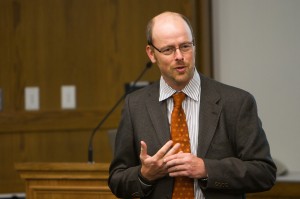Students who transition from one country to another often struggle to adjust to the environment of a new school in a different country.
Edmund T. Hamann, an associate professor from University of Nebraska-Lincoln, spoke at BYU to students and faculty of the McKay School of Education about how to merge the cultural gaps between the U.S. and other countries for students in grades K–12.

Hamann explains that there are some cultural differences that are expected such as “large numbers of Spanish speakers in U.S. schools, transnational migration often associated with poverty and disbursal/division of extended family networks and different experiences with an assumptions about schooling in Mexico versus the U.S.”
An unexpected problem is the New Latino Diaspora or the immigration growth in elementary schools.
Hamann, along with other colleagues, wrote a dissertation and researched the percentage of transnational students in Mexico and the effect it has on their education. His research surveyed 56,010 students; 982 of those students had prior experience in U.S. schools. The team recorded the migration effects on the students and their families in four different states in Mexico.
“We estimated that 1.5% of Mexico’s school enrollment are American citizens,” wrote Hamann.
With such a high number of American citizens in Mexico, bridging cultural gaps is not just information to be implemented in the states, but additionally, it would benefit other countries as well. Hamann explained that an effective way to address these problems is to learn more about the culture and background of the students who migrate either from or to the U.S. to help these students succeed.
“Mexican American families have really important assets, especially those who are immigrants,” said Bryant Jensen, an assistant professor in teacher education at BYU, who also studies trends similar to Hamann. “Assets like lower divorce rates, higher levels of religiosity, lower levels of mental health problems — these assets need to be understood in terms of how they adapt to the U.S., and they need to be understood from schools as well. It’s also important to identify and incorporate what these families do well as a leverage to improve schooling opportunities.”
Ultimately, the message that Hamann communicated is that it is important for teachers to be aware of this culture gap and understand that there are ways to bridge these differences. Primarily, the solution is to get to know the background and situation of the student.
“One of the things I do as a teacher educator is to try to help current and future teachers know more about what might be in play in the lives of some of the students at a school,” Hamann said. “The way you attend to (this issue) is draw to people’s attention and brainstorm how we can build on what kids already know.”
Allie Boyce, a BYU student majoring in elementary education, shared her thoughts on the gravity of the situation.
“(Hamann) explained that it is expected that Latino children are coming from homes where not all their family members live in the U.S. or are coming from low-income homes,” Boyce said. “It is important as a teacher to know those things about your students in the classroom.”




